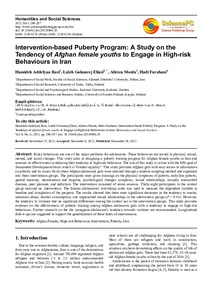Intervention-based Puberty Program: A Study on the Tendency of Afghan female youths to Engage in High-risk Behaviours in Iran
Farahani Hadi; Golamrej Eliasi Laleh; Hamideh Addelyan Rasi Hamideh; Moula Alireza
https://urn.fi/URN:NBN:fi-fe2022022120278
Tiivistelmä
Risky behaviours are one of the major problems for adolescents. These behaviours are rooted in physical, sexual, mental, and social changes. This study aims at designing a puberty training program for Afghan female youths in Iran and assesses its effectiveness in reducing their tendency to high-risk behaviour. The aim of this study is in line with the fifth goal of Sustainable Development Goals which is "Gender equality". This study provides Afghan girls with easy access to information on puberty and its issues. Forty-three Afghan adolescent girls were selected through a random sampling method and organized into three intervention groups. The participants were given trainings on the physical symptoms of puberty, early/late puberty, genital anatomy, menstruation and hygiene, psychological changes symptoms, sexual relationships, sexually transmitted diseases, peer pressure, and addiction. The intervention consisted of seven sessions. Thirty-eight participants in the control group received no intervention. The Iranian adolescents' risk-taking scale was used to measure the dependent variable at baseline and completion of the program. The results showed that there were significant decreases in the tendency to smoke, substance abuse, alcohol consumption, and unprotected sexual relationships in the intervention groups (P < 0.01). However, the tendency to violence had no significant differences among the control nor in the intervention groups. This study provides evidence on the effectiveness of puberty training among Afghan adolescent girls with a tendency to engage in high-risk behaviours. Further research on the the immigrant adolescent’s tendency towards violence are recommended. Longitudinal follow-ups are suggested to support the generalization of these kinds of interventions.
Kokoelmat
- Rinnakkaistallenteet [19204]
